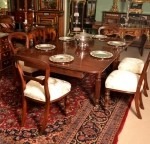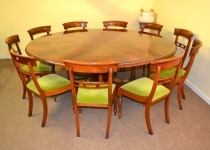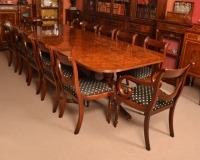Buying an ornate and highly collectable Regency dining table
 A guide to beautiful, decorative early nineteenth century dining tables
A guide to beautiful, decorative early nineteenth century dining tables
A background to the Regency period
Regency dining tables were first produced during the reign of George IV (1811 to 1820) although the style has continued to be reproduced, and to influence designs, right up until the present day. As well as encompassing the actual decade of George IV’s reign the Regency period is often considered more widely to be the transition from the Georgian to the Victorian eras, starting from 1795 and continuing until 1837 and the coronation of Queen Victoria.
This was an age of great change in British society – it was a time of war (French Revolutionary and Napoleonic), of poverty and squalor but also a time of great advancement and refinement; a period of high artistic and cultural innovation and achievement. As Prince Regent the future George IV was centrally involved in this movement as a great patron to artists and designers.
Characteristics of Regency dining tables
The designers and makers of these beautiful decorative tables were influenced by the Neo-Classical taking inspiration from Ancient Greece, Rome and Egypt. These tables were often made of mahogany or burr walnut and featured rosewood and zebrawood veneers, brass decorations, metal paws and lion masks and they were considerably more elaborate than the previous generation of furniture.
Regency dining table components
The basic components of these tables are the top (usually solid wood and rectangular with straight or curved edges) and the legs (which may be carved, reeded or possibly sabre shaped). Some tables may have a central pedestal instead of legs. In addition there maybe drawers (with knobs or pulls); casters or metal paws; extension leaves; side panels; stretchers (a wooden piece connecting the legs) and sometimes additional carved decorations such as small busts or figures on the table sides or at the top of the legs
 Sizes, shapes and styles
Sizes, shapes and styles
The most commonly found Regency dining tables are rectangular and are large enough to seat at least six or eight people. There are also circular, pedestal mounted tables and square tables both of which will usually seat four people. Extra-long Regency dining tables can also be found, these may have been used in large formal dining rooms or even outdoors by extended families and are often supported by multiple sets of legs. Drop leaf and extended leaf designs were also very popular at the time saving space and allowing more flexibility as these tables were widely used in the town houses of the growing middle and merchant classes. All of these shapes and sizes will display many of unique stylistic elements of Regency dining tables including – rosettes (round flower and petal designs which grow out from a central point); masks – carved representations of animals, mythical creatures (lions and winged griffins were especially popular) or masks of Roman gods; metal paw feet; and brass inlays.
Buying the perfect Regency dining table
Regent Antiques offer a range of fabulous Regency dining tables in truly beautiful condition with any necessary restoration done by our specialist in-house craftsmen. Visit our website or London showrooms or call or email for further advice.

